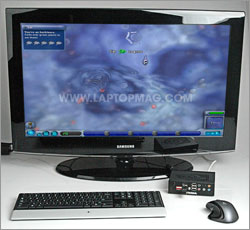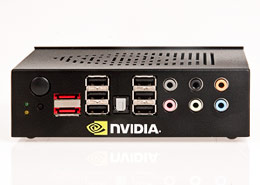Laptop Mag Verdict
Nvidia's coupling of Intel's Atom CPU with its own GeForce 9400 graphics processor provides a major performance boost to low-cost PCs.
Pros
- +
Surprisingly good graphics performance
- +
Smooth video playback
- +
Works well with apps like Google Earth
- +
Compatible with powerful CUDA-optimized apps
Cons
- -
Slow frame rates for highest end games
Why you can trust Laptop Mag
Consider this the opening salvo in Nvidia's mad charge to gain a foothold in the rapidly growing netbook space. Nvidia's Ion platform, which pairs the company's GeForce 9400 graphics processing unit with Intel's 1.6-GHz Atom processor, looks to revolutionize the low-cost graphics market by enabling netbooks, nettops, and other types of value-price PCs to handle graphics-intensive games, full HD (1080p) video, and high-end operating systems such as Windows Vista Home Premium. Based on our tests of a small form factor desktop, Ion blows away Intel's integrated chipset and graphics. However, we would want to see Ion inside a netbook and observe its impact on battery life before calling it the next big thing in bang-for-your-buck computing.
Nvidia Ion: The Basics
Powered by Nvidia's 16-core GeForce 9400 (a version of the 9400M that Nvidia representative stated could be used in small-form PCs and nettops), Ion transforms low-cost Atom-powered systems into machines that offer five to ten times the gaming and video-transcoding performance over Intel's integrated Atom GPU solution, according to Nvidia. This is achieved through the use of CUDA, Nvidia's general-purpose parallel computing architecture that leverages the parallel computing engines in GPUs to solve complex problems swifter than a CPU.
Ion also enables true-fidelity 7.1 HD audio, which combined with the ability to play Blu-ray content (courtesy of PureHD Video technology), makes it a potential multimedia dynamo for low-cost PCs. Nvidia has yet to reveal OEMs that will use Ion in their builds, but says that the first wave of Ion-powered PCs should appear in the second quarter of 2009. Nevertheless, our test build shows that the Ion platform holds much promise.
Reference PC Design
Our 1.4-pound test unit was Nvidia's Ion Reference PC, a small 5.6 x 4.3 x 1.5-inch box that looked very much like an early build of a nettop. There's a thermal vent carved into the top of the box in the shape of Nvidia's "eye" logo, plus extra vents on the side of the unit to help keep it cool. Scattered about the front and back of the Ion box are seven USB 2.0 ports, HDMI, VGA, DisplayPort, and dual-link DVI (which was disabled in this build, but will be fully functional when Nvidia updates Ion's BIOS). The multitude of connection options came in very handy as we were able to add a keyboard, mouse, and attach the system to a 32-inch Samsung monitor (with a native resolution of 1920 x 1080) to get the full PC experience.
Smooth Performance
Sign up to receive The Snapshot, a free special dispatch from Laptop Mag, in your inbox.
In term of performance, Ion proved to run quite smooth. Our Reference PC's engine was composed of a 1.6-GHz Intel Atom N230 processor, which is a nettop version of the familiar N270 that utilizes the same 512K cache and 533-MHz frontside bus, but adds a higher 4-watt power requirement. In conjunction with 2GB of RAM, a 7,200-rpm, 200GB Seagate Momentus hard drive, and Windows Vista Enterprise, the system notched a PCMark Vantage score of 1,306, which was more than 200 points higher than theGigabyte M912, the only other netbook to run the benchmark successfully. Compared against ultraportables, another lightweight class of notebook, Ion's score was (predictably) low: it was more than 1,200 points lower than those full-fledged systems.
Still, we were able to stream content from Hulu.com and work within multiple windows at once without consequence. The Reference PC took 1 minute and 12 seconds to boot into the operating system (which was 15 seconds more than the netbook average), and transferred a 4.97GB folder of mixed media at a rate of 11.8 MBps. That's slightly lower than the netbook average (13.4 MBps), but nearly twice that of theASUS Eee Box nettop(7.7 MBps).
Good Graphics Muscle
Of course, the big news here is the inclusion of the Nvidia GeForce 9400 GPU, which produced results that smoked all other systems with Atom processors (except for theASUS N10Jc, which features a powerful Nvidia GeForce 9300M GS GPU with 256MB of dedicated video memory). On our 3DMark03 and 3DMark06 tests, the Ion platform scored 3,846 and 1,201, respectively; the former score is more than 3,000 points higher than the category average of 802, and the latter is more than 900 points better than other mini-notebooks. Only the N10Jc churned out better graphics performance with scores of 4,911 and 1,583.
Lest you think that Ion only out-muscled low-powered Atom-based machines, it also bested ultraportables, which average 1,655 in 3DMark03, and 858 in 3DMark06. Thin-and-light notebooks' GPUs also proved less effective than Ion with an average score of 2,753 in 3DMark03, but just managed to outpace Nvidia's chipset with an average score of 1,245 in 3DMark06.
Gaming Performance
Click to enlargeNetbooks normally don't pack enough graphics might for us to even consider running our F.E.A.R. test, but the GeForce 9400's 3DMark results warranted an attempt. When we popped the game disc into an external optical drive and ran this older 3D title in autodetect mode (1024 x 768-pixel resolution), the onscreen action moved at a decent 23 frames per second, which makes for a nearly playable game session. When we bumped the resolution up to maximum (1920 x 1080), it chugged along at 11 frames per second. These scores are nearly on a par with the average ultraportable (29 fps/8 fps), but quite lower than the average thin-and-light, at least on autodetect (37 fps/15 fps). Although Ion's numbers aren't gangbusters, they highlight the fact that Ion can at least handle some 3D titles. F.E.A.R. simply won't run on a typical netbook.
The Nvidia GeForce 9400 GPU inside Ion beautifully rendered images in one of the hottest casual games of the moment, Spore. When playing Will Wright's evolution simulation, our created life-forms moved quickly through the primordial ooze even when we bumped the visuals up to their maximum setting to add depth, translucency, and rippling effects. In comparison, the Dell Inspiron Mini 12 choked on the game, sputtering its way through the opening sequence, and moving at a jerky, molasses-slow pace when we began playing.
Despite flexing impressive graphics muscle, we were reminded that the 9400 wasn't designed for high-end, graphics-intensive polygonal games. When we fired up Far Cry 2, we saw rates of 11.9 frames per second when running the game in autodetect mode (1024 x 768), which plummeted to an unplayable 6.2 fps with maximum settings (1920 x 1080). Even at a resolution of 800 x 600, Ion managed only 12.5 fps.
Google Earth, Video Transcoding
Lest you think that strong GPUs benefit only gamers, we went on a trip around New York City and used Google Earth to display various areas of the city. Zooming into our office building showed only the occasional hiccup, as Google Earth rendered the dense gathering of skyscrapers in the area. When we decided to check out the far less crowded Coney Island, buildings and amusement venues loaded quickly and with barely a hint of jerkiness.
Transcoding a 2-minute-and-16-second MPEG clip (720 x 480) to AVI using the open-source HandBrake media converter took 11 minutes and 15 seconds, which was 22 seconds less than the Intel GMA 500 chipset in the Dell Inspiron Mini 12. When we transcoded the same clip into an iPhone-compatible MP4 file using Badaboom (an Nvidia-recommended media converter that uses CUDA technology), the video conversion was done in a lightning fast 2:18 (it took 9:21 to make the conversion with the audio/video settings bumped up to maximum). As the Dell Inspiron Mini 12 doesn't possess CUDA technology, we were unable to run Badaboom on that system.
Battery Life Not Yet Known
The Nvidia Ion Reference PC we tested was AC-powered, so we were unable to run the LAPTOP Battery Test to see if the 4-watt Intel Atom N230 nettop processor reduces a system's endurance significantly more than a 2.5-watt Intel Atom N270 processor. Our previous experience with the 9400M chip in the revampedApple MacBook(4 hours and 45 minutes of battery life), paired with Intel's Core 2 Duo processor, demonstrated that extra GPU performance doesn't necessarily drain the battery at a vastly increased rate. However, we cannot evaluate the impact Ion has on netbook endurance until we can test that kind of device with Nvidia's technology integrated.
Verdict
Click to enlargeSince their inception, netbooks have been touted as secondary PCs that one uses to jump onto the Web to check e-mail and visit favorite sites, mainly due to their low-powered components. Now that we've gotten our hands on the Ion, we think that, should Nvidia's platform be widely adopted, it could change the perception of low-cost PCs, as they will be graphically on a par with your typical ultraportable. You may not be able to play Crysis at a blistering frame rate, but you should be able enjoy a very nice gaming experience on titles that aren't quite as graphically challenging--as well as take advantage of 3D applications like Google Earth and indulge in high-def video content without the processor getting bogged down. Assuming Ion doesn't take too heavy a toll on battery life, and that it doesn't add too much to the cost of these very price-sensitive machines, Nvidia's platform could very well redefine netbooks.
[flq:7e16558844474dee458542ac9be4fd28]
Nvidia Ion Reference PC Specs
| Brand | Nvidia |
| CPU | 1.6-GHz Intel Atom 230 |
| Company Website | http://www.nvidia.com |
| Graphics Card | Nvidia GeForce 9400 |
| Hard Drive Size | 200GB |
| Hard Drive Speed | 7,200rpm |
| Hard Drive Type | SATA Hard Drive |
| Operating System | MS Windows Vista Enterprise |
| Ports (excluding USB) | dual-link DVI, VGA, HDMI, DisplayPort |
| RAM | 2GB |
| RAM Upgradable to | 8GB |
| Size | 5.6 x 4.3 x 1.5 inches |
| USB Ports | 7 |
| Video Memory | 256MB |
| Warranty/Support | N/A |
| Weight | 1.4 pounds |
Jeffrey is a writer at Laptop Mag. His coverage includes chiefly laptop reviews, and he's tried some of the top brands out there, including Acer, Lenovo, MSI, Dell, and Sony. Outside of digging into laptop performance and features, Jeffrey covers things like peripherals and software.


